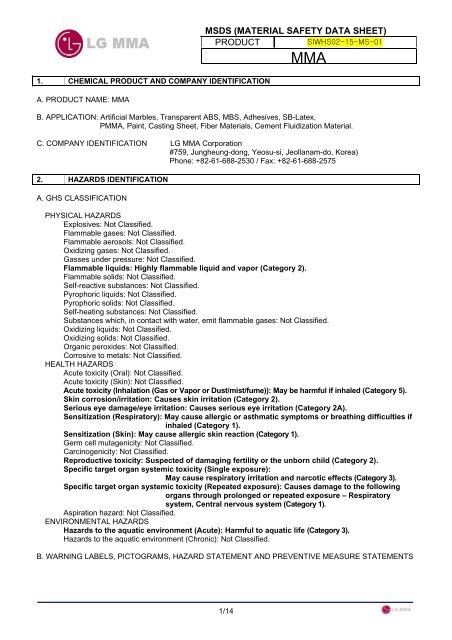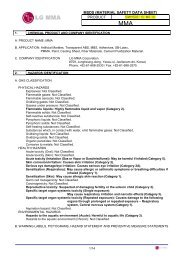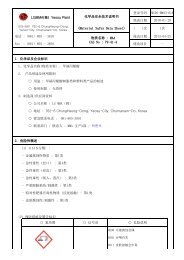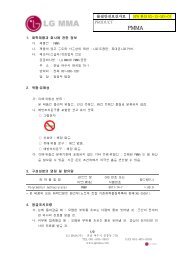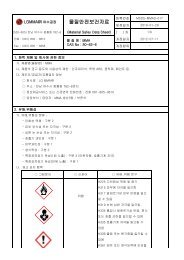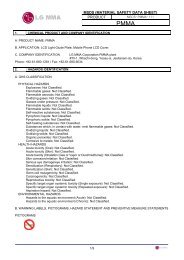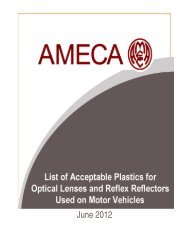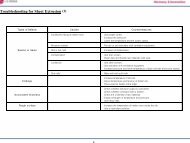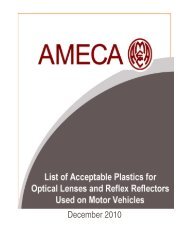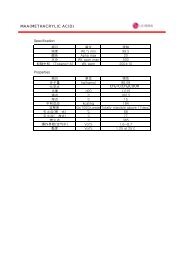MSDS (MATERIAL SAFETY DATA SHEET) PRODUCT - LG MMA
MSDS (MATERIAL SAFETY DATA SHEET) PRODUCT - LG MMA
MSDS (MATERIAL SAFETY DATA SHEET) PRODUCT - LG MMA
You also want an ePaper? Increase the reach of your titles
YUMPU automatically turns print PDFs into web optimized ePapers that Google loves.
1. CHEMICAL <strong>PRODUCT</strong> AND COMPANY IDENTIFICATION<br />
A. <strong>PRODUCT</strong> NAME: <strong>MMA</strong><br />
<strong>MSDS</strong> (<strong>MATERIAL</strong> <strong>SAFETY</strong> <strong>DATA</strong> <strong>SHEET</strong>)<br />
<strong>PRODUCT</strong><br />
SIWHS02-15-MS-01<br />
<strong>MMA</strong><br />
B. APPLICATION: Artificial Marbles, Transparent ABS, MBS, Adhesives, SB-Latex,<br />
P<strong>MMA</strong>, Paint, Casting Sheet, Fiber Materials, Cement Fluidization Material.<br />
C. COMPANY IDENTIFICATION <strong>LG</strong> <strong>MMA</strong> Corporation<br />
#759, Jungheung-dong, Yeosu-si, Jeollanam-do, Korea)<br />
Phone: +82-61-688-2530 / Fax: +82-61-688-2575<br />
2. HAZARDS IDENTIFICATION<br />
A. GHS CLASSIFICATION<br />
PHYSICAL HAZARDS<br />
Explosives: Not Classified.<br />
Flammable gases: Not Classified.<br />
Flammable aerosols: Not Classified.<br />
Oxidizing gases: Not Classified.<br />
Gasses under pressure: Not Classified.<br />
Flammable liquids: Highly flammable liquid and vapor (Category 2).<br />
Flammable solids: Not Classified.<br />
Self-reactive substances: Not Classified.<br />
Pyrophoric liquids: Not Classified.<br />
Pyrophoric solids: Not Classified.<br />
Self-heating substances: Not Classified.<br />
Substances which, in contact with water, emit flammable gases: Not Classified.<br />
Oxidizing liquids: Not Classified.<br />
Oxidizing solids: Not Classified.<br />
Organic peroxides: Not Classified.<br />
Corrosive to metals: Not Classified.<br />
HEALTH HAZARDS<br />
Acute toxicity (Oral): Not Classified.<br />
Acute toxicity (Skin): Not Classified.<br />
Acute toxicity (Inhalation (Gas or Vapor or Dust/mist/fume)): May be harmful if inhaled (Category 5).<br />
Skin corrosion/irritation: Causes skin irritation (Category 2).<br />
Serious eye damage/eye irritation: Causes serious eye irritation (Category 2A).<br />
Sensitization (Respiratory): May cause allergic or asthmatic symptoms or breathing difficulties if<br />
inhaled (Category 1).<br />
Sensitization (Skin): May cause allergic skin reaction (Category 1).<br />
Germ cell mutagenicity: Not Classified.<br />
Carcinogenicity: Not Classified.<br />
Reproductive toxicity: Suspected of damaging fertility or the unborn child (Category 2).<br />
Specific target organ systemic toxicity (Single exposure):<br />
May cause respiratory irritation and narcotic effects (Category 3).<br />
Specific target organ systemic toxicity (Repeated exposure): Causes damage to the following<br />
organs through prolonged or repeated exposure – Respiratory<br />
system, Central nervous system (Category 1).<br />
Aspiration hazard: Not Classified.<br />
ENVIRONMENTAL HAZARDS<br />
Hazards to the aquatic environment (Acute): Harmful to aquatic life (Category 3).<br />
Hazards to the aquatic environment (Chronic): Not Classified.<br />
B. WARNING LABELS, PICTOGRAMS, HAZARD STATEMENT AND PREVENTIVE MEASURE STATEMENTS<br />
1/14
<strong>MSDS</strong> (<strong>MATERIAL</strong> <strong>SAFETY</strong> <strong>DATA</strong> <strong>SHEET</strong>)<br />
<strong>PRODUCT</strong><br />
SIWHS02-15-MS-01<br />
<strong>MMA</strong><br />
PICTOGRAMS<br />
SIGNAL WORD: DANGER.<br />
HAZARD STATEMENTS<br />
Highly flammable liquid and vapor.<br />
May be harmful if inhaled.<br />
Causes skin irritation.<br />
Causes serious eye irritation.<br />
May cause allergic or asthmatic symptoms or breathing difficulties if inhaled.<br />
May cause allergic skin reaction.<br />
Reproductive toxicity: Suspected of damaging fertility or the unborn child.<br />
May cause respiratory irritation and narcotic effects.<br />
Causes damage to the following organs through prolonged or repeated exposure<br />
– Respiratory system, Central nervous system.<br />
Harmful to aquatic life.<br />
PRECAUTIONARY STATEMENTS<br />
PREVENTION<br />
(Physical hazards)<br />
Keep container tightly closed.<br />
Keep away from ignition sources such as heat/sparks/open flame– No smoking.<br />
Wear protective gloves and eye/face protection as specified by the manufacturer/supplier or the competent<br />
authority.<br />
Ground/Bond container and receiving equipment<br />
- if electrostatically sensitive material is for reloading.<br />
- if product is as volatile as to generate hazardous atmosphere<br />
Use explosion-proof electrical/ventilating/lighting/equipment.<br />
- other specified by the manufacturer/supplier or the competent authority.<br />
Take precautionary measures against static discharge.<br />
Use only non-sparking tools.<br />
(Health hazards)<br />
Wear protective gloves as specified by the manufacturer/supplier or the competent authority. Wash thoroughly<br />
after handling.<br />
Wear eye/face protection as specified by the manufacturer/supplier or the competent authority.<br />
Avoid breathing dust/fume/gas/mist/vapors/spray. In case of inadequate ventilation wear respiratory protection<br />
as specified by the manufacturer/supplier or the competent authority.<br />
Wear protective gloves as specified by the manufacturer/supplier or the competent authority. Avoid breathing<br />
dust/fume/gas/mist/vapours/spray. Contaminated work clothing should not be allowed out of the workplace.<br />
2/14
<strong>MSDS</strong> (<strong>MATERIAL</strong> <strong>SAFETY</strong> <strong>DATA</strong> <strong>SHEET</strong>)<br />
<strong>PRODUCT</strong><br />
SIWHS02-15-MS-01<br />
<strong>MMA</strong><br />
Obtain special instructions before use. Do not handle until all safety precautions have been read and understood.<br />
Use personal protective equipment as required.<br />
Use only outdoors or in well-ventilated area. Avoid breathing dust/fume/gas/mist/vapors/spray.<br />
Do not eat, drink or smoke when using this product. Wash hands thoroughly after handling. Do not breathe<br />
dust/fume/gas/mist/vapors/spray.<br />
(Environmental hazards)<br />
Avoid release to the environment<br />
- if this is not the intended use.<br />
RESPONSE<br />
(Physical hazards)<br />
In case of fire, use foam, powder or carbon dioxide for extinction appropriate media specified by the<br />
manufacturer/supplier or the competent authority<br />
IF ON SKIN (or hair): Remove/take off immediately all contaminated clothing. Rinse skin with water/shower.<br />
(Health hazards)<br />
IF INHALED: Call a POISON CENTER or doctor/physician if you feel unwell.<br />
IF ON SKIN: Wash with plenty of soap and water. Take of contaminated clothing and wash before re-use. If skin<br />
irritation occurs, seek medical advice/attention.<br />
IF IN EYES: Rinse cautiously with water for several minutes. Remove contact lenses, if present and easy to do.<br />
Continue rinsing. If eye irritation persists, get medical advice/attention. Wash hands after handling<br />
IF INHALED: If breathing is difficult, remove to fresh air and keep at rest in a position comfortable for breathing.<br />
If experiencing respiratory symptoms call a POISON CENTER or doctor/physician.<br />
IF ON SKIN: Wash with plenty of soap and water. If skin irritation or rash occurs, seek medical advice/attention.<br />
Wash contaminated clothing before reuse.<br />
IF exposed or concerned: Get medical attention/advice.<br />
Call a POISON CENTER or doctor/physician if you feel unwell.<br />
IF INHALED: Remove to fresh air and keep at rest in a position comfortable for breathing.<br />
STORAGE<br />
(Physical hazards)<br />
Store in cool/well-ventilated place.<br />
(Health hazards)<br />
Store locked up.<br />
Store container tightly closed in well-ventilated place.<br />
- if product is as volatile as to generate hazardous atmosphere.<br />
3/14
<strong>MSDS</strong> (<strong>MATERIAL</strong> <strong>SAFETY</strong> <strong>DATA</strong> <strong>SHEET</strong>)<br />
<strong>PRODUCT</strong><br />
SIWHS02-15-MS-01<br />
<strong>MMA</strong><br />
DISPOSAL<br />
Dispose of contents/container in accordance with local/regional/national/international regulation.<br />
C. HAZARDS NOT INCLUDED IN GHS CLASSIFICATION<br />
The vapor mixes well with air, explosive mixtures are easily formed. The product is readily polymerized by light,<br />
heat, or oxidants without inhibitor. If the polymerization takes place inside some containers, it is subject to violent<br />
rupture.<br />
3. COMPOSITION / INFORMATION ON INGREDIENTS<br />
CHEMICAL NAME CAS No. ENCS Number* %(w/w)<br />
Methyl methacrylate (<strong>MMA</strong>) 80-62-6 2-1036 > 99.9<br />
* ENCS Number: Japanese Existing and New Chemical Substances.<br />
4. FIRST AID MEASURES<br />
A. EYE CONTACT<br />
Rinse cautiously with water for several minutes. Remove contact lenses, if present and easy to do. Continue<br />
rinsing. If eye irritation persists, get medical advice/attention.<br />
B. SKIN CONTACT<br />
Remove/take off immediately all contaminated clothing. Rinse skin with water/shower or wash with plenty of<br />
soap and water. If skin irritation or rash occurs, seek medical advice/attention. Wash contaminated clothing<br />
before reuse.<br />
C. INHALATION<br />
If breathing is difficult, remove to fresh air and keep at rest in a position comfortable for breathing. If experiencing<br />
respiratory symptoms or feel unwell, call a POISON CENTER or doctor/physician.<br />
D. INGESTION<br />
Not a likely route of exposure. Do not induce vomiting without medical advice. There may be irritation to the<br />
gastro-intestinal tract with nausea and vomiting.<br />
E. MAJOR TOXIC SYMPTOMS AND EFFECTS<br />
May cause allergy or asthma symptoms or breathing difficulties if inhaled. May cause an allergic skin reaction.<br />
F. NOTE TO PHYSICIAN<br />
Skin contact may aggravate an existing dermatitis condition. Based on the individual reactions of the patient, the<br />
physician's judgment should be used to control symptoms and clinical condition.<br />
5. FIRE FIGHTING MEASURES<br />
A. SUITABLE EXTINGUISHING MEDIA<br />
Foam, powder, carbon dioxide [ICSC].<br />
Do NOT use straight streams of water. Do not use halogenated extinguishing agents.<br />
Water spray may be used to keep fire exposed containers cool.<br />
B. SPECIFIC HAZARDS ARISING FROM THE CHEMICAL<br />
Above flash point, vapor-air mixtures are explosive within flammable limits noted Section 9 (Physical and<br />
chemical properties). Polymerization may be caused by elevated temperature, oxidizers, peroxides, or sunlight.<br />
Vapors can flow along surfaces to distant ignition source and flash back. Sealed containers may rupture when<br />
heated. Sensitive to static discharge.<br />
During a fire, irritating and highly toxic gases may be generated by thermal decomposition or combustion.<br />
C. SPECIAL PROTECTIVE EQUIPMENT AND PRECAUTIONS FOR FIRE FIGHTERS<br />
4/14
<strong>MSDS</strong> (<strong>MATERIAL</strong> <strong>SAFETY</strong> <strong>DATA</strong> <strong>SHEET</strong>)<br />
<strong>PRODUCT</strong><br />
SIWHS02-15-MS-01<br />
<strong>MMA</strong><br />
In case of fire, wear a full face positive-pressure self contained breathing apparatus and protective suit. Keep<br />
containers cool with water spray.<br />
6. ACCIDENTAL RELEASE MEASURES<br />
A. PERSONAL PRECAUTIONS, PROTECTIVE EQUIPMENT AND EMERGENCY PROCEDURES<br />
Eliminate all ignition sources. Restrict access to area as appropriate until clean-up operations are complete. Use<br />
personal protective equipment recommended in Section 8 (Exposure Controls/Personal Protection). Stop or<br />
reduce any leaks if it is safe to do so. Ventilate spill area if possible. Ensure clean-up is conducted by trained<br />
personnel only. Do not touch spilled material. Have emergency equipment (for fires, spills, leaks, etc.) readily<br />
available. Notify appropriate government, occupational health and safety and environmental authorities.<br />
B. ENVIRONMENTAL PRECAUTIONS<br />
Prevent material from entering sewers or waterways. Notify appropriate government, occupational health and<br />
safety and environmental authorities.<br />
C. METHODS AND <strong>MATERIAL</strong>S FOR CONTAINMENT AND CLEANING UP<br />
SMALL SPILLS: Soak up spill with absorbent material (sand or other non combustible adsorbent material). Place<br />
residues in a suitable, covered, properly labeled container. Wash affected area.<br />
LARGE SPILLS: Contain liquid using absorbent material, by digging trenches or by diking. Reclaim into recovery<br />
or salvage drums or tank truck for proper disposal. Clean contaminated surfaces with water or aqueous cleaning<br />
agents. Dispose of material in compliance with regulations indicated in Section 13 (Disposal Considerations).<br />
7. HANDLING AND STORAGE<br />
A. PRECAUTIONS FOR SAFE HANDLING<br />
Do not get in eyes, on skin, on clothing. Do not take internally. Use with adequate ventilation. Do not breathe<br />
vapors/gases/dust. In case of inadequate ventilation wear respiratory protection. Keep the containers closed<br />
when not in use. Use non-sparking type tools and equipment, including explosion proof equipment. Use<br />
connections properly earthed to prevent generation of electrostatic charges. Vapors are heavier than<br />
air and may travel considerable distances to a source of ignition and flash back. Have emergency equipment (for<br />
fires, spills, leaks, etc.) readily available. Ensure all containers are labelled. Do not use, store, spill or pour near<br />
heat, sparks or open flame.<br />
B. CONDITIONS FOR SAFE STORAGE, INCLUDING ANY INCOMPATIBILITIES<br />
Store in suitable labelled containers. Store the containers tightly closed. Store away from heat and sources of<br />
ignition. Protect from direct sunlight. Keep containers placed in cool, well–ventilated areas at temperature not<br />
exceeding 30 ºC. Have appropriate fire extinguishers available in and near the storage area. Store separately<br />
from incompatibles. Connections must be grounded to avoid electrical charges.<br />
* Fill the container by approximately 90 % only as oxygen (air) is required for stabilization. With large storage<br />
containers, make sure the oxygen (air) supply is sufficient to ensure stability [ECETOC].<br />
8. EXPOSURE CONTROLS/PERSONAL PROTECTION<br />
A. OCCUPATIONAL EXPOSURE LIMITS<br />
KOREA<br />
Korea. OELs (ISHL Article 42; MOL Public Notice No. 1986-45, as amended through MOL Public Notice<br />
No. 2007-25, June 8, 2007)<br />
CAS RN: 80-62-6<br />
Name: Methyl methacrylate<br />
The 8-hour TWA: 50 ppm.<br />
The 8-hour TWA: 205 mg/m3<br />
The 15-minute STEL: 100 ppm.<br />
The 15-minute STEL: 410 mg/m3<br />
JAPAN<br />
5/14
<strong>MSDS</strong> (<strong>MATERIAL</strong> <strong>SAFETY</strong> <strong>DATA</strong> <strong>SHEET</strong>)<br />
<strong>PRODUCT</strong><br />
SIWHS02-15-MS-01<br />
<strong>MMA</strong><br />
Japan. OELs - JSOH (Japan Society of Occupational Health: Recommendation of Occupational<br />
Exposure Limits, 2007)<br />
CAS RN: 80-62-6<br />
Name: Methyl methacrylate<br />
Skin sensitizer: 2 (Probable skin sensitizer).<br />
Respiratory sensitizer: 2 (Probable respiratory sensitizer)<br />
OSHA<br />
OSHA Table Z-1 Limits for Air Contaminants (June 30, 1993)(29 CFR 1910.1000)(1971 Permissible<br />
Exposure Limits (PELs))<br />
CAS RN: 80-62-6<br />
Name: Methyl methacrylate<br />
OSHA Z-1 PEL: 100 ppm<br />
OSHA Z-1 PEL: 410 mg/m3.<br />
ACGIH<br />
ACGIH Threshold Limit Values (2007)<br />
CAS RN: 80-62-6<br />
Name: Methyl methacrylate<br />
Sensitizer<br />
Carcinogen Category: A4 (Not Classifiable as a Human Carcinogen)<br />
The 8-Hour Exposure Limit (TLV-TWA): 50 ppm.<br />
The 15-minute STEL: 100 ppm.<br />
NIOSH<br />
NIOSH. Pocket Guide to Chemical Hazards, 2005<br />
CAS RN: 80-62-6<br />
Name: Methyl methacrylate<br />
NIOSH Recommended exposure limit (REL) [for up to a 10-hour workday during a 40-hour<br />
workweek]: 100 ppm.<br />
NIOSH Recommended exposure limit (REL) [for up to a 10-hour workday during a 40-hour<br />
workweek]: 410 mg/m3.<br />
NIOSH Immediately dangerous to life or health (IDLH) concentration: 1,000 ppm.<br />
B. ENGINEERING MEASURES<br />
General ventilation is recommended. Use local exhaust ventilation if necessary to control airborne mist and<br />
vapor. Provide mechanical ventilation of confined spaces.<br />
C. INDIVIDUAL PROTECTION MEASURES<br />
GENERAL ADVICE<br />
The use and choice of personal protection equipment is related to the hazard of the product, the workplace and<br />
the way the product is handled. In general, we recommend as a minimum precaution that safety glasses with<br />
side-shields and work clothes protecting arms, legs and body be used. In addition any person visiting an area<br />
where this product is handled should at least wear safety glasses with side-shields.<br />
RESPIRATORY PROTECTION<br />
Where concentrations in air may exceed the limits given in this section, the use of a half face filter mask or air<br />
supplied breathing apparatus is recommended. If significant mists, vapors or aerosols are generated an<br />
approved respirator is recommended. A suitable filter material depends on the amount and type of chemicals<br />
being handled. If respiratory protection is required, institute a complete respiratory protection program including<br />
selection, fit testing, training, maintenance and inspection.<br />
HAND PROTECTION<br />
It has been demonstrated that <strong>MMA</strong> easily penetrates rubber latex gloves. All vinyl gloves appeared to provide<br />
poorer protection. Polyethylene gloves give the best protection against <strong>MMA</strong> diffusion.<br />
Gloves should be replaced immediately if signs of degradation are observed. Most glove materials are of low<br />
chemical resistance. Consult PPE manufacturers. Replace gloves regularly.<br />
6/14
<strong>MSDS</strong> (<strong>MATERIAL</strong> <strong>SAFETY</strong> <strong>DATA</strong> <strong>SHEET</strong>)<br />
<strong>PRODUCT</strong><br />
SIWHS02-15-MS-01<br />
<strong>MMA</strong><br />
SKIN PROTECTION<br />
When handling this product, the use of a chemical resistant suit and rubber boots is recommended. Keep a<br />
safety shower available.<br />
EYE PROTECTION<br />
When handling this product, the use of splash chemical goggles is recommended. Keep an eye wash fountain<br />
available.<br />
9. PHYSICAL AND CHEMICAL PROPERTIES<br />
A. PHYSICAL APPEARANCE: Clear, colorless liquid.<br />
B. ODOR: Characteristic odor.<br />
C. ODOR THRESHOLD: 0.05 – 0.34 ppm [Amoore J.E., Hautala E.: Odor as an<br />
aid to chemical safety: odor thresholds compared with<br />
threshold limit values and volatilities for 214 industrial<br />
chemicals in air and water dilution; J. Appl. Toxicol. 3:<br />
272–290 (1983)]<br />
D. pH: No data available.<br />
E. MELTING/FREEZING POINT: -48°C [Method: Directive 84/449/EEC, A.1 "Melting<br />
point/melting range"]<br />
F. INITIAL BOILING POINT/BOILING POINT RANGE: 101°C [Method: Directive 84/449/EEC, A.2 "Boiling<br />
point/boiling range"]<br />
G. FLASH POINT: 10°C (Open Cup) [Method: Directive 84/449/EEC, A.9<br />
"Flash point" or ASTM D. 92–52]<br />
H. EVAPORATION RATE: 3.1 (Ethyl acetate = 1)<br />
I. FLA<strong>MMA</strong>BILITY (GAS, SOLID): Not applicable.<br />
J. UPPER AND LOWER EXPLOSION LIMITS: 1.7 – 12.5 [ICSC]<br />
K. VAPOUR PRESSURE: 3.9kPa [ICSC].<br />
L. SOLUBILITY: 15g/L (water, 20°C) [Method: Directive 84/449/EEC,<br />
A.6 "Water solubility"]<br />
M. RELATIVE VAPOUR DENSITY: 3.5 (air=1, 20°C) [ICSC and IUCLID]<br />
N. SPECIFIC GRAVITY: 0.944<br />
O. n-OCTANOL/WATER PARTITION COEFFICIENT: 1.38 [Method: other (measured): as OECD 107, flask<br />
shaking method]<br />
P. AUTOIGNITION TEMPERATURE: 421°C (1,013 hPa)<br />
Q. DECOMPOSITION TEMPERATURE: No data available.<br />
R. VISCOSITY: 0.60 mPa s at 20°C (method: DIN 51 562)<br />
10. STABILITY AND REACTIVITY<br />
A. CHEMICAL STABILITY<br />
Inhibited methyl methacrylate is stable at room temperature for a limited storage period. Vapors are uninhibited<br />
and may form polymers in vents, causing stoppage. Polymerization may be caused by elevated temperature,<br />
oxidizers, peroxides, or sunlight.<br />
B. POSSIBILITY OF HAZARDOUS REACTIONS<br />
The product is readily polymerized by light, heat, or oxidants without inhibitor. If the polymerization takes place<br />
inside some containers, it is subject to violent rupture [IUCLID].<br />
C. CONDITIONS TO AVOID<br />
Insufficient inhibitor, incompatibles, heat, flame and ignition sources.<br />
D. INCOMPATIBLE <strong>MATERIAL</strong>S<br />
Contact with polymerization catalysts (e.g. peroxides, persulfates), nitric acid, strong oxidizers and other bases<br />
(e.g. ammonia, amines), halogens and halogen compounds.<br />
7/14
E. HAZARDOUS DECOMPOSITION <strong>PRODUCT</strong>S<br />
Oxides of carbon (COx).<br />
11. TOXICOLOGICAL INFORMATION<br />
A. INFORMATION ON THE LIKELY ROUTES OF EXPOSURE<br />
EYE CONTACT: Yes.<br />
SKIN CONTACT: Yes.<br />
INGESTION: No.<br />
INHALATION: Yes (vapor, mist).<br />
<strong>MSDS</strong> (<strong>MATERIAL</strong> <strong>SAFETY</strong> <strong>DATA</strong> <strong>SHEET</strong>)<br />
<strong>PRODUCT</strong><br />
SIWHS02-15-MS-01<br />
<strong>MMA</strong><br />
B. SYMPTOMS RELATED TO THE PHYSICAL, CHEMICAL AND TOXICOLOGICAL CHARACTERISTICS<br />
No data available.<br />
C. DELAYED AND IMMEDIATE EFFECTS AND ALSO CHRONIC EFFECTS FROM SHORT AND LONG TERM<br />
EXPOSURE<br />
ACUTE TOXICITY:<br />
- Oral: The product is not acute toxic according to GHS (Globally Harmonized Systems classification system).<br />
- Skin: The product is not acute toxic according to GHS (Globally Harmonized Systems classification system).<br />
- Inhalation: Mist or vapor may irritate the respiratory tract. Mist or vapor may cause headache, chest pain,<br />
vomiting, nausea and narcosis. Very high levels may cause pulmonary edema and death.<br />
SKIN CORROSION/IRRITATION:<br />
Causes irritation to skin.<br />
SERIOUS EYE DAMAGE/IRRITATION:<br />
Irritating, and may injure eye tissue if not removed promptly.<br />
RESPIRATORY OR SKIN SENSITIZATION:<br />
Prolonged or frequently repeated skin contact may cause allergic reactions in some individuals.<br />
Inhalation of product mist or vapors may cause respiratory allergy in some individuals.<br />
GERM CELL MUTAGENICITY:<br />
Not expected to cause mutagenicity based on some mutagenicity assay.<br />
CARCINOGENICITY:<br />
IARC Overall Evaluation: 3 (not classifiable as to carcinogenicity in humans).<br />
ACGIH Carcinogen Category: A4 (not classifiable as to carcinogenicity in humans).<br />
None of the substances in this product are listed as carcinogens in humans by the International Agency for<br />
Research on Cancer (IARC), American Conference of Governmental Industrial Hygienists (ACGIH) or the<br />
National Toxicology Program (NTP).<br />
RE<strong>PRODUCT</strong>IVE TOXICITY:<br />
Caused teratogenic effects (maternally toxic, foetal toxicity) on laboratory animals [EU-RAR No.22 (2002)].<br />
SPECIFIC TARGET ORGAN/SYSTEMIC TOXICITY – SINGLE EXPOSURE:<br />
May cause respiratory irritation and narcotic effects.<br />
SPECIFIC TARGET ORGAN/SYSTEMIC TOXICITY – REPEATED EXPOSURE:<br />
Causes damage to respiratory system and central nervous system through prolonged or repeated exposure.<br />
8/14
<strong>MSDS</strong> (<strong>MATERIAL</strong> <strong>SAFETY</strong> <strong>DATA</strong> <strong>SHEET</strong>)<br />
<strong>PRODUCT</strong><br />
SIWHS02-15-MS-01<br />
<strong>MMA</strong><br />
ENVIRONMENTAL HEALTH CRITERIA:<br />
None known. No data available.<br />
ASPIRATION HAZARD:<br />
None known. No data available.<br />
D. NUMERICAL MEASURES OF TOXICITY (SUCH AS ACUTE TOXICITY ESTIMATES)<br />
ACUTE ORAL TOXICITY:<br />
Species LD50 Test Descriptor / Reference<br />
Rat 7,872 mg/kg RTECS<br />
ACUTE DERMAL TOXICITY:<br />
Species LD50 Test Descriptor / Reference<br />
Rabbit > 5,000 mg/kg RTECS<br />
ACUTE INHALATION TOXICITY:<br />
Species LC50 Test Descriptor / Reference<br />
Rat 78,000 mg/m3/4hrs RTECS<br />
SKIN IRRITATION:<br />
Rabbit 0.5 ml, occluded, 4 hour, effect: Moderately irritating [Rohm and Haas (1982)].<br />
EYE IRRITATION:<br />
Rabbit, effect: Moderately irritating [Rohm and Haas (1988)].<br />
MUTAGENICITY:<br />
Salmonella typhimurium reverse mutation assay: 10–10,000 ug/plate (+-S9), result: negative (OECD 471 (1987)).<br />
Micronucleus assay (in vivo): mouse, result: negative (Method: OECD 474 (1991)).<br />
SENSITIZATION:<br />
Guinea pig (guinea pig maximization test), result: sensitizing.<br />
For sensitization, the experimental dentin primers were diluted with olive oil and acetone 7 : 3 (v/v). As antigen<br />
<strong>MMA</strong> was tested at concentrations of 0.2, 1 and 5 % by weight [Katsuno K., Manabe A., Itoh K., Hisamitsu H.,<br />
Wakumoto S., Nakayama S., Yoshida T.; A delayed hypersensitivity reaction to dentin primer in the guinea pig;<br />
J. Dent. 23(5): 295 – 299 (1995)].<br />
12 ECOLOGICAL INFORMATION<br />
A. TOXICITY<br />
ACUTE FISH RESULTS:<br />
Species Exposure LC50 Test Descriptor / Reference<br />
Lepomis macrochirus 96 hrs 191 mg/L EPA, 1975<br />
Oncorhynchus mykiss 96 hrs > 79 mg/L<br />
EPA, 40 CFR Part 797 Guideline<br />
797.1400<br />
ACUTE INVERTEBRATE RESULTS:<br />
Species Exposure EC50 Test Descriptor / Reference<br />
Daphnia magna (Crustacea) 48 hrs 69 mg/L EPA, 1975, flow through protocol<br />
Daphnia magna (Crustacea) 24 hrs<br />
720 mg/L<br />
1,042 mg/L (EC100)<br />
-<br />
9/14
<strong>MSDS</strong> (<strong>MATERIAL</strong> <strong>SAFETY</strong> <strong>DATA</strong> <strong>SHEET</strong>)<br />
<strong>PRODUCT</strong><br />
SIWHS02-15-MS-01<br />
<strong>MMA</strong><br />
AQUATIC PLANTS (e.g. A<strong>LG</strong>AE) RESULTS:<br />
Species Exposure EC50 Test Descriptor / Reference<br />
Scenedesmus quadricauda<br />
(Algae)<br />
7 days 37 mg/L -<br />
Scenedesmus quadricauda<br />
(Algae)<br />
4 days 170 mg/L OECD Guideline 201 (1990)<br />
B. PERSISTENCE AND DEGRADABILITY<br />
The organic portion of this substance is expected to be biodegrade to a moderate extent.<br />
- Biodegradation: 88 % after 28 days (aerobic).<br />
* 60 % biodegradation was not reached within 10 days of passing the 10 % level<br />
Result: Not readily biodegradable according to EEC criteria [OECD–guideline 301 D, GLP (1992)].<br />
- Biodegradation: 32 % after 28 days (aerobic)<br />
[OECD Guide–line 301 C "Ready Biodegradability: Modified MITI Test (I)" (1989)].<br />
- Biodegradation: 94.3 % (14 days (BOD test)) [Safety assessment for Existing Chemicals, JAPAN (1992)].<br />
C. BIOACCUMULATIVE POTENTIAL<br />
<strong>MMA</strong> is not expected to significantly bioaccumulation due to low bioaccumulation factor (BCF).<br />
- BCF = 2 – 6.59 (Method: calculated) [Lyman W.J., Reehl W.F., Rosenblatt D.H.; Handbook of chemical<br />
property estimation methods; Environmental behavior of organic compounds; McGraw–Hill, New York, NY,<br />
4.2–4.33, 5.1–5.30 (1982)]<br />
- BCF = 2.350 (Method: calculated) [Safety assessment for Existing Chemicals, JAPAN (2002)]<br />
D. MOBILITY IN SOIL<br />
If <strong>MMA</strong> released into the soil, <strong>MMA</strong> is expected to quickly evaporate.<br />
On the basis of its vapor pressure and its low absorption to soil (K= 21.3 – 34), <strong>MMA</strong> is expected to volatilize<br />
relatively rapidly from soil [Online literature search, Environfate data base, 1991 SRC, 1988].<br />
E. OTHER ADVERSE EFFECTS<br />
None known. No data available.<br />
13. DISPOSAL CONSIDERATIONS<br />
A. DISPOSAL METHODS<br />
Must be disposed of as a special waste in accordance with regulations for special waste.<br />
Small quantities may be incinerated under controlled conditions in incinerators suitable for methacrylates.<br />
Hazardous wastes must be transported by a licensed hazardous waste transporter and disposed of or treated in<br />
a properly licensed hazardous waste treatment, storage, disposal or recycling facility.<br />
Consult local, state, and federal regulations for specific requirements.<br />
B. PRECAUTIONS (ON DISPOSAL OF COTAMINATED CONTAINERS AND PACKAGES)<br />
Do not dispose of wastes in local sewer or with normal garbage. Combustion products are carbon monoxide,<br />
carbon dioxide and water.<br />
14. TRANSPORT INFORMATION<br />
* The following results are for the product.<br />
A. UN NUMBER: 1247.<br />
B. UN PROPER SHIPPING NAME: METHYL METHACRYLATE MONOMER, STABILIZED.<br />
* Technical Name(s) -<br />
C. TRANSPORT HAZARD CLASS(ES): 3.<br />
D. PACKING GROUP, IF APPLICABLE: II.<br />
10/14
<strong>MSDS</strong> (<strong>MATERIAL</strong> <strong>SAFETY</strong> <strong>DATA</strong> <strong>SHEET</strong>)<br />
<strong>PRODUCT</strong><br />
SIWHS02-15-MS-01<br />
<strong>MMA</strong><br />
E. ENVIRONMENTAL HAZARDS: Not regulated.<br />
F. SPECIAL PRECAUTIONS FOR USER: No data available.<br />
15. REGULATORY INFORMATION<br />
<strong>SAFETY</strong>, HEALTH AND ENVIRONMENTAL REGULATIONS<br />
EUROPE: This chemical substance is classified in the Annex I of Directive 67/548/EEC.<br />
Hazard symbols:<br />
Indication(s) of danger:<br />
F, Xi<br />
Risk phrases:<br />
R11: Highly flammable.<br />
R37/38: Irritating to respiratory system and skin.<br />
R43: May cause sensitization by skin contact.<br />
Safety phrases:<br />
S2: Keep out of the reach of children.<br />
S24: Avoid contact with skin.<br />
S37: Wear suitable gloves.<br />
S46: If swallowed, seek medical advice immediately and show this container or label.<br />
U.S. FEDERAL, ENVIRONMENT<br />
Clean Air Act Section 111, SOCMI Intermediate or Final Volatile Organic Compounds (40 CFR 60.489)<br />
CAS RN: 80-62-6<br />
Name: METHYL METHACRYLATE<br />
Clean Air Act Section 112, Hazardous Air Pollutants, as amended by 40 CFR 63 (December 19, 2005)<br />
CAS RN: 80-62-6<br />
Name: METHYL METHACRYLATE<br />
Hazardous Organic NESHAP (HON) Synthetic Organic Chemicals (40 CFR 63.100-.106, Table 1)<br />
CAS RN: 80-62-6<br />
Name: METHYL METHACRYLATE<br />
Hazardous Organic NESHAP (HON) Hazardous Air Pollutants (40 CFR 63.100-.106, Table 2)<br />
CAS RN: 80-62-6<br />
Name: METHYL METHACRYLATE<br />
Clean Water Act Section 311 Hazardous Chemicals (40 CFR 116.4)<br />
CAS RN: 80-62-6<br />
Name: METHYL METHACRYLATE<br />
Clean Water Act Section 311 Hazardous Substances (40 CFR 117.3)<br />
CAS RN: 80-62-6<br />
Name: METHYL METHACRYLATE<br />
The Reportable Quantity Code: C<br />
The Reportable Quantity is:1000 lbs.<br />
RCRA Appendix VII: Hazardous Constituents (40 CFR 261, App. VII, Basis for Listing Hazardous Waste)<br />
CAS RN: 80-62-6<br />
Name: METHYL METHACRYLATE<br />
RCRA Appendix VIII List of Hazardous Constituents (40 CFR 261)<br />
CAS RN: 80-62-6<br />
11/14
<strong>MSDS</strong> (<strong>MATERIAL</strong> <strong>SAFETY</strong> <strong>DATA</strong> <strong>SHEET</strong>)<br />
<strong>PRODUCT</strong><br />
SIWHS02-15-MS-01<br />
<strong>MMA</strong><br />
Name: 2-PROPENOIC ACID, 2-METHYL-, METHYL ESTER<br />
EPA Hazardous Waste Number: U162<br />
RCRA D List of Characteristic Hazardous Wastes (40 CFR 261.21-24)<br />
CAS RN: 80-62-6 regulated as a member of the Generics group for CAS RN: D001<br />
Generics group name: UNLISTED HAZARDOUS WASTE: CHARACTERISTIC OF IGNITABILITY<br />
The EPA Hazardous Waste Number: D001<br />
NIOSH Recommended Safety and Health Standards for Hazardous Agents in the Workplace, Health Effects<br />
CAS RN: 80-62-6<br />
Name: METHYL METHACRYLATE<br />
NIOSH Health Effects: Respiratory irritation<br />
U.S. FEDERAL, RIGHT-TO-KNOW<br />
CERCLA Hazardous Substances [other than radionuclides] (40 CFR 302.4)<br />
CAS RN: 80-62-6<br />
Name: 2-PROPENOIC ACID, 2-METHYL-, METHYL ESTER<br />
The Reportable Quantity (RQ):1000 lbs.<br />
EPCRA (SARA Title III) Section 313 Toxic Chemical (Reporting Form R Instructions for 2006, as revised January<br />
2007)<br />
CAS RN: 80-62-6<br />
Name: METHYL METHACRYLATE<br />
De Minimis Concentration for Section 313:1.0 %.<br />
Reporting threshold for manufacturing and processing: 25000 lbs<br />
Reporting threshold for other uses: 10000 lbs<br />
HMIS Chemical Ratings (Hazardous Materials Information System, Chemical Ratings Guide, Third Edition, 2002)<br />
CAS RN: 80-62-6<br />
Name: METHYL METHACRYLATE<br />
Health Hazard: 2 Moderate.<br />
Chronic Health Hazard: -<br />
Flammability Hazard: 3 Serious.<br />
Physical Hazard: 1 Slight.<br />
CANADA<br />
Canada. WHMIS Ingredient Disclosure List (Can. Gaz., Part II, Vol.122, No.2, January 20, 1988)<br />
CAS RN: 80-62-6<br />
Name: METHYL METHACRYLATE<br />
Canada's WHMIS item number from English Ingredient Disclosure List: 1059<br />
Canada's WHMIS Concentration Threshold: 1 %.<br />
Quebec. Guidance WHMIS Classifications (CSST/SRT), May 5, 2007<br />
CAS RN: 80-62-6<br />
Name: METHYL METHACRYLATE<br />
Classification: B2, D2B<br />
Disclosure level: 1.0 %<br />
Disclosure according to Ingredient Disclosure List<br />
CHINA<br />
China. List of Dangerous Goods (GB 12268-2005)<br />
CAS RN: 80-62-6<br />
Name: METHYL METHACRYLATE MONOMER, STABILIZED<br />
UN Dangerous Goods Number(s) (UN Number): 1247<br />
Dangerous Goods Classification(s): 3<br />
Dangerous Goods Packing Group(s): II<br />
China Dangerous Goods Number(s) (CN Number): 32149<br />
Note(s): Flammable liquids<br />
China. Classification and Labeling of Dangerous Chemical Substances Commonly Used (GB 13690 - 92)<br />
CAS RN: 80-62-6<br />
Name: METHYL METHACRYLATE (STABILIZED)<br />
12/14
<strong>MSDS</strong> (<strong>MATERIAL</strong> <strong>SAFETY</strong> <strong>DATA</strong> <strong>SHEET</strong>)<br />
<strong>PRODUCT</strong><br />
SIWHS02-15-MS-01<br />
<strong>MMA</strong><br />
Classification Section: Class 3: Combustible Liquids: Medium flashing point liquid<br />
Classification: F (Flammable)<br />
Dangerous Properties: 5.22, 5.104, 5.109<br />
Labeling: Exposure to excessive heat, open flame or strong oxidizing agents can readily cause fire.<br />
KOREA<br />
Korea. Dangerous Substances Threshold Quantity (Presidential Decree of Dangerous Substances Safety<br />
Management Act No. 18406, Schedule 1, May 29, 2004)<br />
CAS RN: 80-62-6<br />
Generics group name: No. 1 water-insoluble petroleum liquids with a flash point below 21°C<br />
Class: 4 (Flammable Liquids)<br />
Threshold quantity: 200 liters<br />
NATIONAL FIRE PROTECTION ASSOCIATION - NFPA Ratings (USA)<br />
Health: 2, Flammability: 3, Reactivity: 2, Specific hazard: -<br />
0 = Insignificant 1 = Slight 2 = Moderate 3 = High 4 = Extreme<br />
INTERNATIONAL CHEMICAL CONTROL LAWS<br />
EUROPE<br />
The substance in this product is included in or exempted from the EINECS or ELINCS inventories.<br />
U.S.<br />
The substance in this product are included on or exempted from the TSCA 8(b) Inventory (40 CFR 710).<br />
JAPAN<br />
The substance in this product is comply with the Law Regulating the Manufacture and Importation of Chemical<br />
Substances and are listed on the Ministry of Economy, Trade and Industry (METI).<br />
KOREA<br />
The substance in this product is comply with the Toxic Chemical Control Law (TCCL) and<br />
is listed on the Existing Chemicals Inventory (KECI).<br />
Toxic Chemicals List - None of the component of this product is regulated under TCCL.<br />
Observational Chemicals List - None of the component of this product is regulated under TCCL.<br />
16. OTHER INFORMATION<br />
This product material safety data sheet provides health and safety information. The above information is<br />
believed to be correct but does not propose to be all inclusive and shall be used only as a guide. <strong>LG</strong> <strong>MMA</strong><br />
Corporation shall not be held liable for any damage resulting from handling or from contact with the above<br />
product. Each individual should make a determination as to the suitability of the information for their particular<br />
purpose(s). Various government agencies may have specific regulations regarding the transportation, handling,<br />
storage, use, or disposal of this product which may not be covered by this <strong>MSDS</strong>. The user is responsible for full<br />
compliance.<br />
A. REFERENCES<br />
Guideline for Globally Harmonized System of Classification and Labelling of Chemicals (GHS).<br />
Regulated chemicals info. produced by the National Institute of Technology and Evaluation (Japan).<br />
WHO/IPCS:International Chemical Safety Cards (ICSC).<br />
EU European Chemicals Bureau (ECB): International Uniform Chemical Information Database (IUCLID).<br />
Registry of Toxic Effects of Chemical Substances (NIOSH).<br />
Registry of Toxic Effects of Chemical Substances (RTECS).<br />
Joint Assessment of Commodity Chemicals, Methyl methacrylate No. 30, European Centre for Ecotoxicology<br />
and Toxicology of Chemicals, Brussels (1995) (ECETOC).<br />
European Union Risk Assessment Report (European Commission) (EU-RAR).<br />
13/14
<strong>MSDS</strong> (<strong>MATERIAL</strong> <strong>SAFETY</strong> <strong>DATA</strong> <strong>SHEET</strong>)<br />
<strong>PRODUCT</strong><br />
SIWHS02-15-MS-01<br />
<strong>MMA</strong><br />
Ariel WebInsight DB (3E Company).<br />
B. OTHER INFORMATION<br />
- Date issued: 27 October 2007<br />
- Version number (GHS): 1.0<br />
- Technical Support on the <strong>MSDS</strong>: RGB Chemicals Co., Ltd. (http://rgbchemicals.com).<br />
14/14


